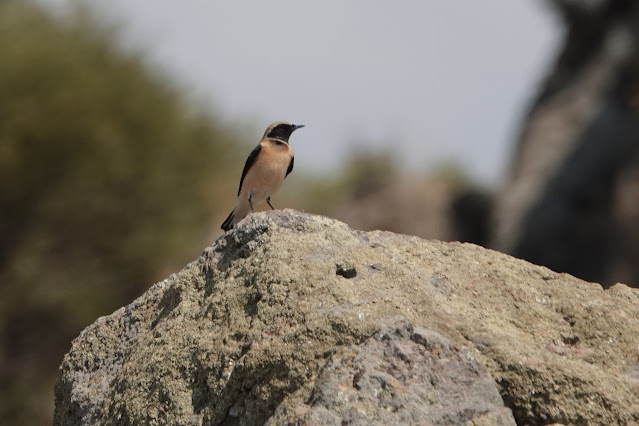There was almost full cloud cover
and even a good rain shower during breakfast which, after a night of continued
north easterly winds hinted that birds may have been deposited overnight. As it
happened it was not to be but there were still signs of passage with Bee-eaters
and flava Wagtails being visible all day. Over 400 of the latter had gone over
the Pela before 8am!
The first run at the Lotzaria trail produced nothing new but
good views again of Hoopoe and the Chats and Shrikes and down in the Tsiknias
Lower Ford two Black Storks were feeding for the first time this trip with Grey
Heron, Little and Great White Egrets while the Greenshank was still zooming
around. A male Cretzschmar's Bunting was in to top of a Walnut, Tawny Pipits
'chupped' from the fields and a flock of 75 Bee-eaters spiralled overhead.
 |
| Little Egret, Black Stork & Grey Heron |
 |
| Little Egret |
 |
| Great White Egret |
 |
| Little Egret & Greenshank |
 |
| Black Stork |
 |
| Black Stork |
 |
| Grey Heron |
 |
| Greenshank, Black Storks & Grey Heron |
 |
| Black Storks & Grey Heron |
 |
| Black Stork |
 |
| Black Storks & Grey Heron |
 |
| Bee-eaters |
 |
| Bee-eaters - imagine the sound |
A vast pack of about 1000 Sparrows seemed to be mostly
Spanish and the numbers have increased dramatically. Down towards the Pumping
Station a Fan-tailed Warbler zipped up and down in the long golden grass and
was my first for a few years here and grass hued Whinchats dotted the fields.
 |
| Spanish Sparrows |
 |
| With that white sub ocular patch I reckon that this is a good candidate for a Syke's Wagtail - M f beema |
 |
| Syke's Wagtail - M f beema |
The Marsh Sandpiper was still on the Corner and a Lesser Grey Shrike was on the
telephone wires. Two Short-toed Eagles and another Black Stork circled and five
elastic winged Alpine Swifts put on a spectacular display up and down the
channel giving some of my best views ever. A chance glance back towards town
revealed an Osprey hunting along the beach.
 |
| Black Stork |
 |
| Black Stork |
 |
| A distant Osprey |
 |
| Alpine Swift |
 |
| Alpine Swift |
Onto Metochi where an adult Whiskered Tern was a surprise
and it performed lazy circuits of the lake, dipping occasionally for a small
fish. Green and Common Sandpipers and two Greenshank were feeding and the edges
look great for Crakes. Red-rumped Swallows glided around me and more Bee-eaters
circled with a couple more Alpine Swifts.
 |
| Whiskered Tern & Green Sandpiper |
 |
| Whiskered Tern - I really struggled to get anything sharp in the strong light and wavy heat haze |
 |
| Red-veined Darter |
 |
| Red-veined Darter |
 |
| Greenshank |
The fields up into Metochi village
were investigated and there were lots of Shrikes (including a couple of adult
male Red-backed), Spotted Flycatchers, Eastern Black-eared and Northern
Wheatears, Whinchats, Stonechats, both Whitethroats and lots of Swallows and
Martins.
 |
| 'Black-throated' Eastern Black-eared Wheatear - ACV |
 |
| 'Black-eared' Eastern Black-eared Wheatear |
 |
| 1st winter Eastern Black-eared Wheatear - ACV |
 |
| Spotted Flycatcher - ACV |
 |
| Woodchat Shrike |
 |
| Woodchat Shrike |
 |
| male Red-backed Shrike |
Up over the ridge a swirling mass over well of 100 Bee-eaters
spiralled through but I was more distracted by the Oriental Hornets feeding on
Grapes with Great Banded Grayling and two of the biggest Violet Carpenter Bees
I have ever seen nectaring on the Chaste Trees.
 |
| Violet Carpenter Bee |
 |
| Oriental Hornet - the grapes were lovely too! |
There were only Little Grebes, two Coots and a Moorhen on
the Hidden Potamia pool whose name I forget and I am still hopeful of a Pygmy
Cormorant there one day!
 |
| Looking up Potamia |
Siesta time and then back out onto Lotzaria where I added a
stunning female Lesser Fiery Copper to my island butterfly list as well as a
migrant Rush Veneer moth. The river looks good but was devoid of birds above
the Ford so I had a quick look at the Eastern Pans which drew a blank before a
final trundle back through the middle into the sun where the Marsh Sandpiper was actually wondrously illuminated.
 |
| female Lesser Fiery Copper |
 |
| female Lesser Fiery Copper |
 |
| Rush Veneer |
 |
| A medium sized Tabinid... |
 |
| Great White Egret |
 |
| Marsh Sandpiper |
 |
| male Red-backed Shrike - all ACV |
Of course two Ortolans
chose to drink from puddles at the most awkward of angles but at least they are
still there and a first winter Black-headed Bunting came up from the pathside
but kept going which was frustrating. Once again Bee-eaters were encountered
with over 50 milling around and at last affording some perched views. A single White Stork in one of the wet fields was a much expected tick for the trip.
 |
| Ortolan #1 |
 |
| Ortolan #2 |
 |
| Bee-eater |
 |
| White Stork |
It was Thekla's birthday that evening so there was no
twilight excursion for Nightjars especially after the huge G'n'T that appeared
in front of me...
 |
| Hummingbird Hawkmoth roosting in a flower pot |



































































No comments:
Post a Comment